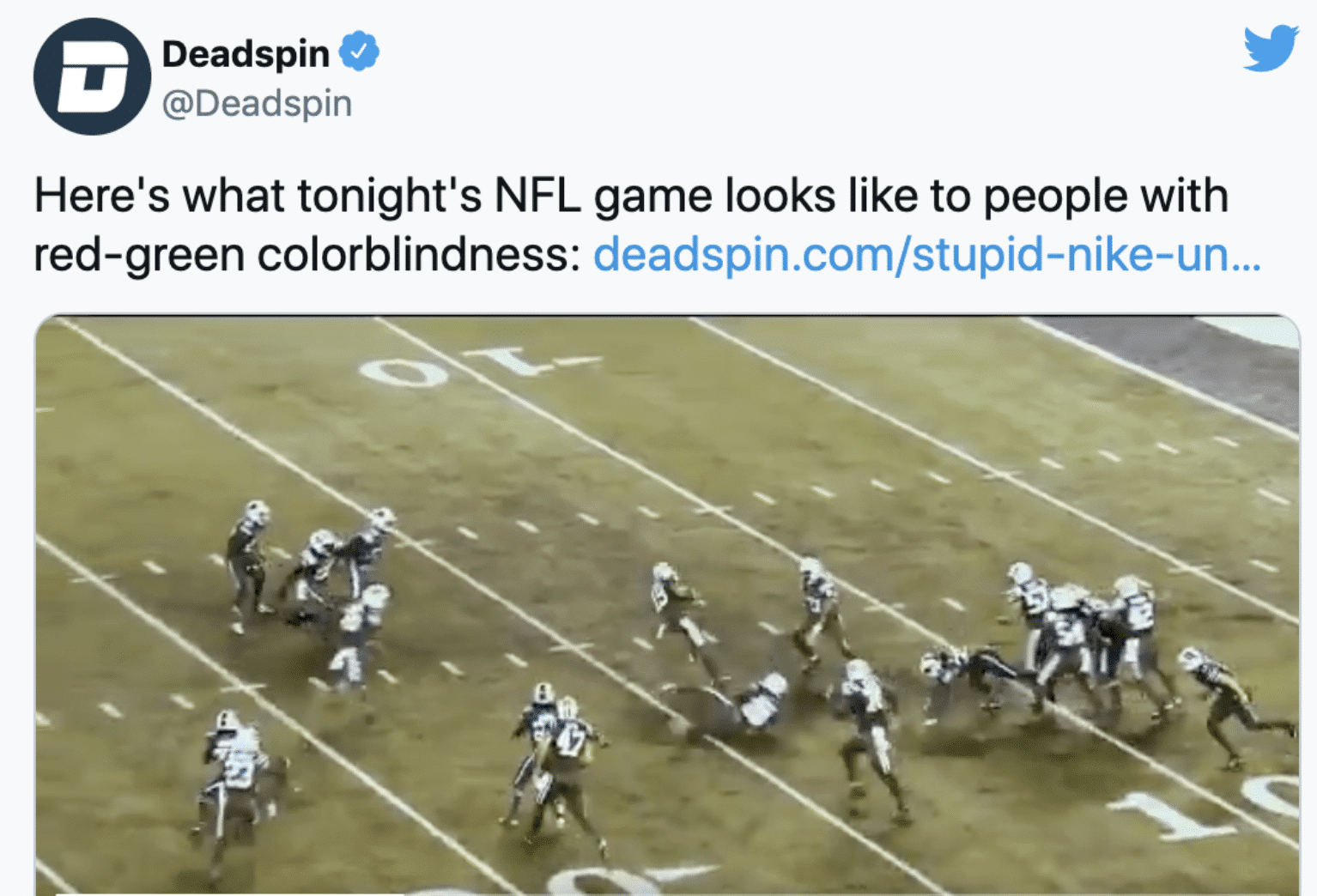Brand Strategy 101: How to Design Your Brand for Everyone

Any brand today that doesn’t take its civic role and responsibility seriously is playing with fire - and potentially inviting legal pitfalls.
A few years ago, the NFL was celebrating the 50th anniversary of its first-ever game broadcast on television in color. The game between the Jets and the Bills had each team wear “Color Rush” uniforms—the Jets all decked out in Green, the Bills in all red.

The NFL is the most popular sport in the U.S. A lot of people, including a lot of men, watch these games. But 8% of American men, about 13 million of them, are colorblind, and the most popular color blindness is red/green. For a sizable chunk of the audience, the game was virtually impossible to follow.
All companies have a target market, but that doesn’t mean that their brands should ignore any segment of the population. Every successful brand of today is a brand that is designed in an inclusive way.
Sixty-one million adults in the U.S. have a disability, while 6% of the U.S. population identifies as LGBTQ. Along with the many ethnic and cultural backgrounds that make up our society, we live in an increasingly diverse and inclusive world. Designing your brand so that it can resonate with everyone isn’t just a nice thing to do or something to do in hopes of staving off criticism. It’s simply good business.
Brands today operate from a place of responsibility and civic-mindedness. That may seem odd, considering companies are private entities. But with trust in government and institutions waning, particularly across younger generations, brands have and must continue to, step up. Any brand today that doesn’t take its civic role and responsibility seriously is playing with fire – and potentially inviting legal pitfalls. People are flocking to brands that share their values and show they care.
Brands that are designed for everyone should ensure that they do not ignore any of the following key aspects of modern, inclusive brand building:
Accessibility
Accessibility isn’t something that can merely be tacked on at the end of the process of creating and honing a brand. In order to ensure accessibility across the board, new companies and startups should bake accessibility into the fabric of the brand. Today’s society is one, rightly, of inclusion and openness.
Regardless of ability, socioeconomic status, or background, more people than ever have access to information. A brand that wants to be its best self is one that ensures that it can communicate with, and be relevant to, all people. No brand wants to automatically eliminate itself from consideration by any group of people right off the bat, and those who do not build their brand through an accessibility lens are doing just that.
Though you, yourself, may not be colorblind, a more-sizable-than-you-realize portion of your audience will be. There are a number of color combinations that are difficult or impossible for colorblind folks to discern. Among them: Green & Red; Green & Brown; Blue & Purple; Green & Blue; Light Green & Yellow; Blue & Grey; Green & Grey; Green & Black. Monochromatic options are a good bet—and look pretty sweet if done well, too.
This doesn’t just go for your logo, but everywhere your brand appears visually. On social media and on your website, make sure any and all accent colors don’t clash, muddle, or present issues for colorblindness (think links, hovers, images, etc.). In general, a good rule of thumb is to go with high contrast choices.
This will help ensure that not only does your brand look good to you, but to everyone (and may help you avoid legal issues as well).
A website is a crucial part of any business—yes, even in these days of social media, TikToks, and Alexa. When you’re building your website, it’s imperative that you ensure that the site is accessible for all people. Here are a few things, in particular, to consider (and yes, we could do a better job ourselves – we’re working to improve and re-launch C42D.com at this very moment):
- Make sure your site is fully accessible by audio. This means, don’t skimp on any of those back-end fields on your website’s CMS, including those like the “image alt” text. This ensures that those who are visually impaired and who may rely on-screen text readers are able to get the same experience on your site as everyone else.
- Check that your site is keyboard-input accessible. This means that your site is fully navigable for those who are unable to use a mouse or trackpad.
- Though this seems to be pretty out of style anyway, make sure that your site avoids any aggressive or strobe-like visual effects. Simpler is almost always better!
- Make sure every video on your site is closed captioned. And avoid using any sounds or aural cues that the hearing impaired will not be able to experience.
- Contrast is important for more than your brand’s logos and colors, but for the text on your site and digital platforms. Make sure that you use high contrast between text and backgrounds to ensure legibility for all.
- Avoid using small font sizes or using intricate fonts. Simpler—and in this case, bigger—is always better.
- Here is a great resource for web accessibility: https://www.w3.org/WAI/fundamentals/accessibility-intro/
Language
It’s critical for a brand to have its own voice. Your writing, wherever it appears, should be unique and appropriate to your specific brand. The language you use is important to get your message across clearly in a way that invokes the emotions you want people to feel about your brand.
But all good writing (including marketing copy) comes from constraints, too. From an inclusivity standpoint, it’s important that you take the time to ensure you’re not using any phrases or words that could be misunderstood depending on one’s cultural background, the region they live in, or their age. Avoid leaning too heavily on he/him/she/her pronouns, when “they” can work just as effectively, if not more.
When using descriptive language, avoid words that can be used as metaphors like “crazy”, “sick”, “insane”, and the like, whose original meaning may describe those with certain challenges. This isn’t to penalize creativity or bold use of language. In fact, these words have been overused and point to a lack of creativity. Take this as a challenge to come up with better, more creative, and more impactful words!

Who represents your brand?
In any imagery you use in your marketing and branding, it’s important to ensure that the people you “cast” to represent your brand also represent the true face of the marketplace.
The latest U.S. Census data was just released, and the share of the population who identifies as white dropped to 57%. That share is even smaller amongst the younger generations. So if you want to present an accurate face of the population when marketing your brand, keep that in mind.
This isn’t just true for skin tones, but for disability, age, and body type as well. There is a whole world out there of unique people who all are potential customers of your brand. It’s important for your brand, and for our society as well, that all of us can see ourselves represented in media and imagery.
Closing Thoughts
A brand today must live its values, and prove every day to consumers that it can be a companion for them, regardless of that persons’ individual characteristics. Being an inclusive brand doesn’t mean an overhaul of your branding, strategy, and purpose. It simply means that you make sensible considerations that ensure your brand can connect with everybody. And since when has any brand not wanted to be loved by all?
If this article helped you, please help us by sharing it or recommending it to a friend. Thank you!


